The quest for elixir of life - Episode 3 - Inflammageing
They are super-heroes. They are supposed to protect us from evil. But, when they grow older, does it affect their judgement? Do they do more damage than help? Meet the immune cells in health and ageing. What happens to them as we age? Why do we call for them more often? What happens to their superpowers as we get old? Can they enlighten us in our quest for elixir of life?
Image by Eneas De Troya | CC BY 2.0
Recap
In the previous episodes we explored the role of DNA damage and repair in ageing. In the next episode, we also explored the role of mitochondria in ageing. We found that damage in the cells accumulate over time. And the ability of cells to repair the damage declines with age. We saw how mitochondria contributes to the damage as well - its function declines with age and it produces more ROS. We also saw some evidence that ROS can act as a two edged sword and ROS associated damage might not be all that is there. Mitochondrial renewal goes down and these aged inefficient mitochondria which are more prone to causing cell death and impede stem cell function, accumulate. We figured that caloric restriction and its mimics act by not only improving DNA repair but also by reducing the source of damage. But until now we mostly focused on damage that happens within cells and originates from within them. But we have not paid attention to tissue damage and damage that occurs from messed up interaction of cells. Hence, today we are going to look at the ageing immune system and its contribution to ageing of an individual.
Ageing - a story of thousand wounds!
Image by Clker-Free-Vector-Images | Pixabay.
I had previously touched on this topic in blog post on contribution of inflammation to type 2 diabetes. We saw there that chronic low grade systemic inflammation causes type 2 diabetes. But, we also saw that this inflammation increases with age; and, it also correlates with thin old individuals who get type 2 diabetes. Usually, inflammation occurs when there is a wound or a pathogen. The first responders, the cells of innate immune system (macrophages, neutrophils, etc) come to site of injury or infection and take measures to prevent further damage. However, if inflammation persists chronically in the tissue it may cause tissue damage (see these blogs to learn more about wound healing and fibrosis). You can think of an old age body as a system which has endured many wounds over the course of time. Some mental, some physical. Some external and visible, but others internal and silent cellular stresses. Some that came with lifestyle choices, but others that happened as wear and tear to the body and were inevitable. All of these wounds calling for help from superheroes of immune system. But, why do these superheroes eventually lose the war? Let's see
What are they fighting against?
by @sciecneblocks
Bad lifestyle choices may accelerate chronic inflammation
But, this rather gets us to a very interesting question, what started this low grade inflammation in first place? Well one factor can be lifestyle choices - the food we eat, cigarettes we smoke, infections we endure, LDL-cholesterol in blood, fat we gain or stress we ignore. But, it occurs in mice models too, whose life choices in a lab cage are much less fucked up than ours (Tomay et al., 2018). Also, it has been observed in literature, that even after taking care of lifestyle factors, the systemic low grade inflammation occurs anyway. This hints that there are other innate factors at play (Sandana et al., 2018). So overall, lifestyle does play a crucial role in how gracefully we age and what will be our inflammatory profile. But, they are more of an add on, than being the sole reason.
The senescent cells accumulate and call for help.
By @scienceblocks
We already saw earlier that aged mitochondria promotes ageing. One of the source of chronic inflammation can arise of many cells accumulating damaged mitochondria and even producing more reactive oxygen species causes damage in cells and the tissue. The damage is recognised by nearby cells which causes them to send signals - inflammatory cytokines - which calls for recruitment of immune cells.
In fact , the cells that have more dysfunctional mitochondria and produce more ROS in body are the senescent cells. The senescent cells accumulate in the body with age(He and Sharpless, 2017). In fact, clearance of these senescent cells in mouse models slows down age associated organ damage and even reduce cancer incidence (Baker et al., 2016, Baker et al., 2011)
Not only these non dividing old cells have issues with mitochondria, but they also have their telomeres eroded and higher chances of DNA damage and genomic instability. In an attempt to not go haywire they activate ATM, P53 and P16 pathways. The DNA damage response pathways, such as activation of ATM, also leads to activation of p38MAPK, NFkB and inflammasome (a protein complex in cells that mediates secretion of inflammatory cytokines) pathways (see Miyamoto, 2011, Freeund et al., 2011). NFkB, not only causes inflammation but also promotes survival of these senescent cells. Another way to activate inflammasome, is via damaged mitochondria in these cells activating a protein called NLRP3 (Kauppinen, 2017). The activation of these pathways in senescent cells causes a senescence associated secretory phenotype (SASP). They secrete abundant inflammatory cytokines, such as IL1b, IL8, TNF-alpha and IL6, which then leads to recruitment of immune cells. Moreover, these cytokines and signals has an additional side effect. They cause more nearby cells to become senescent - causing senescence to spread through the tissue - a vicious cycle (Acosta et al., 2013).
Then, these senescent cells also end up having increased activity of retrotransposable elements (RTEs) (the genes of ancient retroviruses (relatives of today's HIV), that became a part of our genome, now called jumping genes because they hop around in our DNA). This causes an increased secretion of interferons which again causes recruitment of immune cells and promote cellular senescence in nearby cell. Now, the jumping of retrotransposons is dependent on an enzyme called reverse-transcriptase, just like for any retrovirus such as HIV. In fact, in curious result Cecco et al., 2019, were able to show that a reverse transcriptase inhibitor could block the age associated inflammation.
But here is the fun part. The invading immune cells are supposed to get rid of these senescent old guys. But the accumulation of these senescent cells with age argues that something overrides it. One possibility is that these old cells over time also tend to increase pro-survival factors. The other being they are generated faster than immune system can handle. Yet another possibility is that chronic inflammation rather promotes senescence further. For instance, in this paper, Jurk et al., show that making a mice with specific deletion of one of the subunits of NFKb causes a chronic inflammatory phenotype in mice. The mice show accelerated ageing and increased accumulation of senescent cells in different tissues. They show that this can be reversed by use of anti-inflammatory drug - ibuprofen or via an anti-oxidant drug. But be careful about use of ibuprofen, as authors did not test it's affect on life-span. Nonetheless, this gives us a hint that not only senescent cells recruit immune cells, but under certain contexts immune cells promote senescent cells in the tissue. Though, more research on this is required to know how it all works out.
Super-heroes age too!
And then the stem cells said - let there be myeloid cells.
Image by Mikael Häggström and A. Rad | CC BY-SA 3.0
Anyway, in another scenario the immune system ages itself. As it turns out the hematopoietic stem cells(HSCs), themselves shows some changes with age. If you don't know, these are the stem cells in body that gives rise to all the blood cells. Now, there are two groups of immune cells in the body - the myeloid lineage (neutrophils, macrophages, mast cells -- the innate immune system) and lymphocyte lineage (T cells and B cells -- the adaptive immune system). The basic difference between them is that the former is a much more crude police that are first responders and takes care of all kinds of infections, injury, cellular insults, debris and basically anything that calls out for them. The adaptive guys are more of a specialized task force. They choose their targets and destroy only pathogens and cells containing antigens that they find problematic. It so happens, that as we age the HSCs are more biased towards making the myeloid cells, both in mice and human (Pang et al., 2011, Dykstra et al., 2011). The decreased potency for lymphoid differentiation and increased potency for myeloid differentiation maybe relevant in many age related pathologies. For instance from scarring to solid tumors the cells of adaptive immune system help in healing without causing much tissue damage. But on the other hand persistent inflammation from cells of innate immune cells can promote tissue fibrosis and carcinogenesiscarcinogenesis (but be careful as it is not as black and white as I mention).
Affect of age on super-powers of heroes.
Image by Greg Luerman | CC BY-SA 3.0
Then the myeloid cells that come to rescue are themselves a little lethargic, in old age as compared to their young versions; even though their numbers aren't affected much (Chatta et al., 1994). On other hand these granulocytes, monocytes and macrophages in aged individual has a different receptor profile. They seem to represent an activated state, while at the same time they have reduced expression of receptors - that help them recognize senescent cells and present antigens to T and B cells (Martinis et al., 2004). This kind of explains why despite high inflammation in tissue old people are more prone to infections and accumulate senescent cells. Think of this situation like making hulk angry without a context, he might unable to tell other avengers about who is the enemy, while at the same time causing unwanted destruction.
Furthermore, their phagocytotic activity is altered. For instance the macrophages in young are much better at clearing up dead apoptotic cells than in old. The neutrophils have similar midlife crisis too (Wenisch et al., 2000). Plus for neutrophils their migration into and out of the tissue is affected, as well (Wenisch et al., 2000).
Imagine it like fate of king's Landing if you watch Game of Thrones. If the neutrophils fail to respond to tissue insult, the insult would damage the tissue. However if neutrophils do come, it's like Daenerys on her dragon, and if it overstays it's welcome, it's going to burn tissue to ashes. The impaired chemotaxis of neutrophils out of the tissue and their prolonged lifespan in the tissue are two such factors that might explain age associated neutrophil inflammation (Oliveira et al., 2016). Moreover, the spiderman like activity of neutrophils of throwing net on their targets is also altered with age. Then, the other myeloid cells such as dendritic cells are also not spared. The cytokines they produce and signalling in the aged innate immune cells is altered, like bigtime. The result - they become more damaging than helpful, overall (Shaw et al., 2013).
The curse of cellular debris
Given that increase in amount of senescent cells, decreased mitochondrial quality - it is not surprising if you find an increase in some cellular debris production and decrease in its clearing up in old individuals. The debris include uncleared dead cells, free DNA from floating around in extracellular matrix and even byproducts of unhealthy mitochondria. Intracellular proteins, N-glycans, ATP and DNA roaming free in extracellular space are recognized as damage associated molecular patterns or DAMPs. Our body is not use to seeing them outside. The resident cells and resident immune cells then activate pattern recognition pathways, that causes these cells to secrete inflammatory cytokines that recruit cells of innate immune system (Poli et al., 2017, Dall'Olio et al., 2013, Feldman et al., 2015). Worse if they are aged immune cells which talk more than they work. Say, a trapped neutrophil which causes more damaged cells and molecules than it gets rid of. Moreover aged immune cells have altered toll like receptor profile,
and hence inefficient pattern recognition and response towards it. That's another vicious cycle, right there.
Decreasing sex hormones and increasing inflammation
Another feature which changes as we age is our hormone profile. For instance the levels of testosterone and oestrogen goes down. These hormones not only maintain our sex life, but may also contribute to keeping the inflammation low. So it is likely that decrease in these hormones causes an increase in levels of inflammatory cytokine, IL6 (Maggio et al., 2006, Abu-Taha et al., 2009). If these cytokines go up they will eventually lead to inflammation of tissues expressing them.
Is obesity just early ageing of adipose tissue?
Then, our metabolic profile also change as we age. I mean if you were paying attention the mitochondrial quality decline with age that we saw in last episode, it must have given it away. This effect may play an important role in how adipose tissue turnover in young vs old individuals. What we see in adipose tissue is that as we age, the adipose tissue not only redistributes but it also becomes pro-inflammatory. It accumulates a lot more macrophages. In fact when we look closer we can find a lot of adipose cells, pre-adipocytes and other cells of mesenchymal origin, display a senescent and pro-inflammatory state in old mice and men (Tchkonia et al., 2010). In fact, some researchers have proposed that obesity is a prematurely aged adipose tissue.
Summary
In a nutshell, what we saw in today's article is when we get old we get a low grade chronic inflammation in our body. We focused majorly on discussing what are potential sources of this inflammation. We found that both lifestyle and innate factors may contribute to age associated inflammation. While we covered a lot of it, there are other factors like chronic latent infections, such as with CMV, that you might want to check out. I also left out role of gut microbiome in inflammation and ageing . Also, what we did not talk today is role of phychological stress and stress hormones as we age. I will visit these topics in future, nevertheless. Anyhow, in the next episode, we will look into effect of caloric restriction on inflammation and take our quest further. In the meantime, you can focus on living a healthy lifestyle to minimize and delay the inevitable inflammation.
About steemstem
But, before I go I would like to mention about the steemstem platform. Well, if you love reading and writing interesting science articles @steemstem is a community on steem that support authors and content creators in STEM field. If you wish to support steemstem do see the links below.
You can vote for steemstem witness here -Quick link for voting for the SteemSTEM Witness(@stem.witness)
Quick delegation links for @steemstem
50SP | 100SP | 500SP | 1000SP | 5000SP | 10000SP).
Delegating to @steemstem gives ROI of 65% of the curation rewards.
Also, if you have any questions regarding steemstem, do join the steemstem discord server.
You can DM me on discord, I have the same handle - @scienceblocks. Also if you are not a steem user, and reading this blog inspired you to start your science blog, find me on discord and let me know about you. I can try and help you navigate your way through steem.
References
The quest for elixir of life - understanding caloric restriction (episode 1 - DNA damage and repair)
The quest for elixir of life - understanding caloric restriction (episode 2 - mitochondria)
Type 2 Diabetes - from the eyes of immune cells.
The biology and physics of wound healing (part 1 - the cellular players and dynamics of healing)
Fibrosis-an overscarring wound
Cecco et al., 2019. L1 drives IFN in senescent cells and promotes age-associated inflammation
Jurk et al., 2014. Chronic inflammation induces telomere dysfunction and accelerates ageing in mice

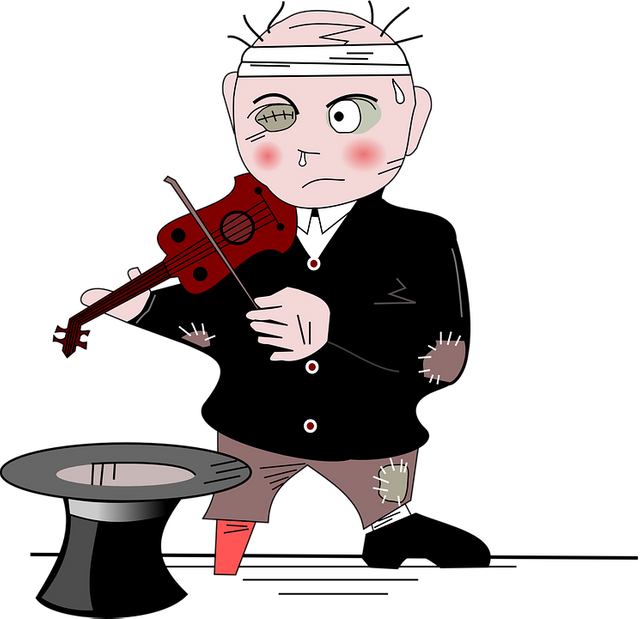
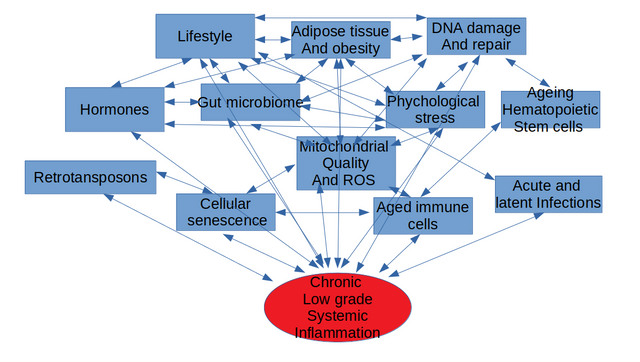
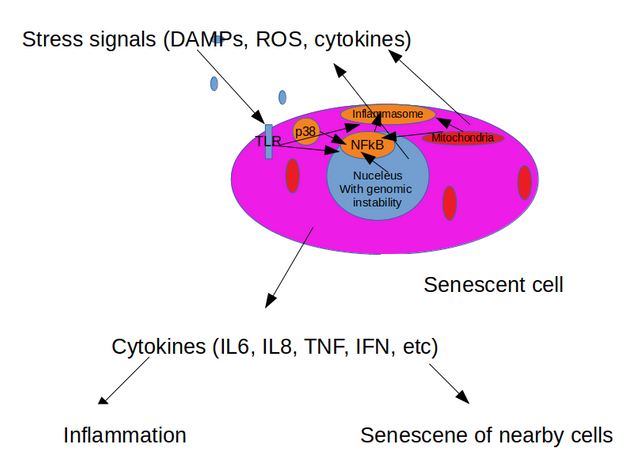
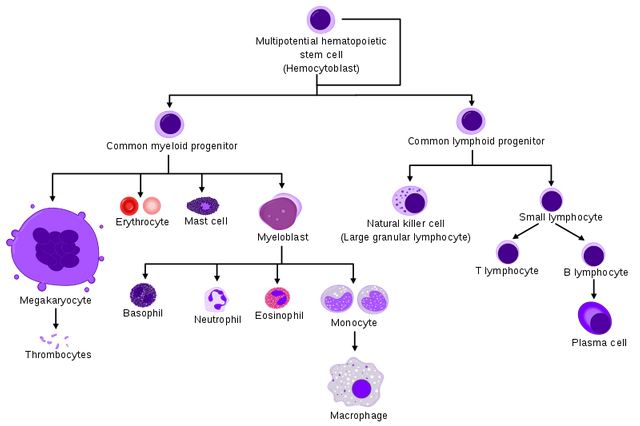
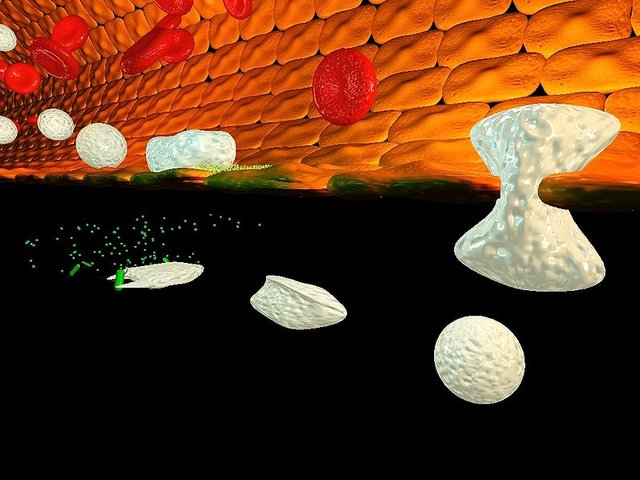
I think of a few autoimmune illnesses that are more common later in life, such as autoimmune encephalitis, which usually strikes over the age of 55. Is that because of the accumulated, lifetime burden of inflammation, or because the body cannot defend any longer against the assault? Also, I guess with diabetes.
I am not aware of clear direction that have been established to know the cause and effect. But provided the current knowledge, what you said seems likely. There are however few more factors to be considered. For instance the amount of auro-antibodies produced also goes up with ageing. There might be a few reasons for this - 1) The regulatory lymphocytes (TRegs, for instance) function declines with ageing. These are the cells that acts like police to mellow down things. A component of complement system such as c1q also interacts with mitochondria in deciding the fate of some adaptive immune cells - how will they respond to self-antigens. Since we know mitochondria gets fucked up in ageing, this may also be another axis for autoantibody production.
The third axis is more in relation to your question. It has been shown body can produce auto-antibodies against inflammatory cytokines. Their function is mostly to neutralize the cytokines, such as TNFalpha. While this might have some benefits in a long run - such as in chronic low grade systemic inflammation it may break the immune cells tolerance to self-antigens. This may exaggerate the autoimmune related inflammation at the site. And, hence act towards promotion of auto-immune diseases.
However, further studies are required to establish a clean mechanistic picture. As of now these are most likely hypotheses which can be considered. On the other hand autoimmune condition may promote inflammation and accelerate ageing. There are some suggestions floating around the idea of testing drugs given in auto-immune diseases for other ageing pathologies.
Thank you for that thorough explanation. In my family, we have a rather uncommon incidence of autoimmune diseases--a couple that are rather rare. Not all of these were expressed later in life, but several were. It's always fascinated me how our friend (the immune system) becomes our enemy, and sometimes ferociously.
I will be rereading your response slowly and carefully so I understand more.
I love this line
Thanks for that:)
I enjoy your blogs. They are science, but I sense in them a tinge of compassion for those who are affected by the hard reality of science.
Thanks for those last lines. Means a lot :)
Posted using Partiko Android
🙂
Hey @scienceblocks,
pretty nice article! I also worked with things like this previously.
Resteem.
Best
Chapper
Thanks a lot @chappertron 🙂
Posted using Partiko Android
Eat your colored fruits and veggies, I guess! Did they use a kind of over-the-counter supplement-like antioxidant or was it a potent chemichy-type drug?
Works the other way around too, I guess?
That's interesting. I was reading @rycharde's self-experiments just yesterday. Let's see what you give us!
As long as two bodies can meet each other and produce a new body that will live a fourscore years, it means the solution is in there somewhere. The body knows, but it's keeping immortality a tight-lipped secret! ☝
They used BHA, an antioxidant, which is a food additive used in animal feed.
Yes
Ah! Nice, I will be reading those self experiments today, in that case.
That's a nice way of putting it out, I would say.
Posted using Partiko Android
Hi @scienceblocks!
Your post was upvoted by @steem-ua, new Steem dApp, using UserAuthority for algorithmic post curation!
Your UA account score is currently 3.373 which ranks you at #6978 across all Steem accounts.
Your rank has not changed in the last three days.
In our last Algorithmic Curation Round, consisting of 184 contributions, your post is ranked at #177.
Evaluation of your UA score:
Feel free to join our @steem-ua Discord server
This post has been voted on by the SteemSTEM curation team and voting trail. It is elligible for support from @curie and @utopian-io.
If you appreciate the work we are doing, then consider supporting our witness stem.witness. Additional witness support to the curie witness and utopian-io witness would be appreciated as well.
For additional information please join us on the SteemSTEM discord and to get to know the rest of the community!
Please consider setting @steemstem as a beneficiary to your post to get a stronger support.
Thanks for having used the steemstem.io app. You got a stronger support!
Hi @scienceblocks!
Your post was upvoted by Utopian.io in cooperation with @steemstem - supporting knowledge, innovation and technological advancement on the Steem Blockchain.
Contribute to Open Source with utopian.io
Learn how to contribute on our website and join the new open source economy.
Want to chat? Join the Utopian Community on Discord https://discord.gg/h52nFrV
Congratulations @scienceblocks! You received a personal award!
You can view your badges on your Steem Board and compare to others on the Steem Ranking